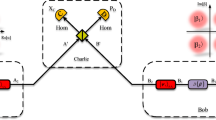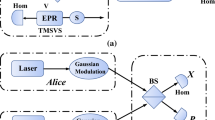Abstract
Aiming at the high cost of quantum equipment and the difficulty of preparing discrete variable quantum states, a measurement-device-independent continuous variable semi-quantum key distribution (MDI-CV-SQKD) protocol is proposed. We, respectively, give the prepared-measure model and the entanglement-based (EB) model of the MDI-CV-SQKD protocol. Based on the EB model, we analyze the secret key rate and other performance of the protocol and perform numerical simulations. Then we analyze the amount of information transmitted by the channel under different attacks. As long as the channel parameters meet certain conditions, secure communication can be carried out. Through parameter adjustment, the solution can achieve the maximum secret key rate. The protocol has the advantages of easy preparation of continuous variables quantum states, low cost of semi-quantum user equipment, and high utilization of full quantum users. It also has characteristics such as the unconditional security of the full quantum protocol, the resistance to the detector side-channel attack of the measurement-device-independent protocol, and the extension of the transmission distance. Therefore, this protocol has important practical value.









Similar content being viewed by others
Data availability
All data and models generated or used during the study appear in the submitted article.
References
Bennett, C.H., Brassard, G.: Quantum Cryptography: Public Key Distribution and Coin Tossing. In: Proceedings of IEEE International Conference on computers, systems and signal processing, Bangalore,10–19 Dec 1984, pp. 175–179. https://doi.org/10.1016/j.tcs.2011.08.039.
Kwek, L.C., Cao, L., Luo, W., et al.: Chip-based quantum key distribution. AAPPS Bull. (2021). https://doi.org/10.1007/s43673-021-00017-0
Chai, G., Li, D., et al.: Blind channel estimation for continuous-variable quantum key distribution. Quant. Eng. 2(2), e37 (2020). https://doi.org/10.1002/que2.37
Guo, H., et al.: Toward practical quantum key distribution using telecom components. Fund. Res. 1(1), 96–98 (2020). https://doi.org/10.1016/j.fmre.2020.12.002
Long, G.L., Xiao, S.L.: Theoretically efficient high-capacity quantum-key-distribution scheme. Phys. Rev. A 65(3), 032302 (2002). https://doi.org/10.1103/PhysRevA.65.032302
Zhang, H., et al.: Realization of quantum secure direct communication over 100 km fiber with time-bin and phase quantum states. Light Sci. Appl. (2022). https://doi.org/10.1038/s41377-022-00769-w
Boyer, M., Kenigsberg, D., Mor, T.: Quantum key distribution with classical bob. Phys. Rev. Lett. (2007). https://doi.org/10.1103/PhysRevLett.99.140501
Liu, W.-J., Chen, Z.-Y., Ji, S., Wang, H.-B., Zhang, J.: Multi-party semi-quantum key agreement with delegating quantum computation. Int. J. Theor. Phys. 56(10), 3164–3174 (2017). https://doi.org/10.1007/s10773-017-3484-6
Shukla, C., Thapliyal, K., Pathak, A.: Semi-quantum communication: protocols for key agreement, controlled secure direct communication and dialogue. Quant. Inf. Process. 16, 295 (2017). https://doi.org/10.1007/s11128-017-1736-2
Yan, L.-L., Zhang, S.-B., et al.: Semi-quantum key agreement and private comparison protocols using bell states. Int. J. Theor. Phys. 58(11), 3852–3862 (2019). https://doi.org/10.1007/s10773-019-04252-y
Zhu, D., Wang, X., Zhu, H.: Semi-quantum-honest key agreement scheme with three-particle entangled states in cross-realm setting. Quant Inf Process (2020). https://doi.org/10.1007/s11128-020-02879-z
Rong, Z., Qin, D., Mateus, P., et al.: Mediated semi-quantum secure direct communication. Quant. Inf. Process. 20(2), 1–13 (2021). https://doi.org/10.1007/s11128-020-02965-2
Rong, Z., Qin, D., Zou, X.: Semi-Quantum secure direct communication using entanglement. Int. J. Theor. Phys. (2020). https://doi.org/10.1007/s10773-020-04447-8
Srikara, S., Thapliyal, K., Pathak, A.: Continuous variable direct secure quantum communication using Gaussian states. Quant. Inf. Process. 19, 4 (2022). https://doi.org/10.1007/s11128-020-02627-3
Xie, C., Li, L., Situ, H.: Semi-quantum secure direct communication model based on Bell states. J. Theor. Phys. (2018). https://doi.org/10.1007/s10773-018-3713-7
Yan, L., Zhang, S., Chang, Y., et al.: Semi-quantum private comparison protocol with three-ppaper G-like states. Quant. Inf. Process 20, 17 (2021). https://doi.org/10.1007/s11128-020-02960-7
Boyer, M., Gelles, R., Kenigsberg, D., Mor, T.: Semi-quantum key distribution. Phys. Rev. A. (2009). https://doi.org/10.1103/PhysRevA.79.032341
Zou, X., Qiu, D., Li, L., et al.: Semiquantum-key distribution using less than four quantum states. Phys. Rev. A 79(5), 1744–1747 (2009). https://doi.org/10.1103/PhysRevA.79.052312
Wang, J., Zhang, S., Zhang, Q., Tang, C.J.: Semi quantum key distribution using entangled states. Chin. Phys. Lett. (2011). https://doi.org/10.1088/0256-307X/28/10/100301
Hajji, H., Baz, M, E. (2021): Qutrit-based semi-quantum key distribution protocol. Quant. Inf. Process. 10. 1007 /s11128–020–02927–8
Yu, K.F., Yang, C.W., Liao, C.H., et al.: Authenticated semi-quantum key distribution protocol using Bell states. Quant. Inf. Process. 13, 1457–1465 (2014). https://doi.org/10.1007/s11128-014-0740-z
Meslouhi, A., Hassouni, Y.: Cryptanalysis on authenticated semi-quantum key distribution protocolusing Bell states. Quant. Inf. Process. 16, 18 (2017). https://doi.org/10.1007/s11128-016-1468-8
Zebboudj, S., Djoudi, H., Lalaoui, D., et al.: Authenticated semi-quantum key distribution without entanglement. Quant. Inf. Process. 19, 77 (2020). https://doi.org/10.1007/s11128-019-2573-2
Krawec, W.O.: Mediated semiquantum key distribution. Phys. Rev. A (2015). https://doi.org/10.1103/PhysRevA.91.032323
Liu, Z.R., Hwang, T.: Mediated semiquantum key distribution without invoking quantum measurement. Ann. Phys. (2018). https://doi.org/10.1002/andp.201700206
Lin, P.H., Tsai, C.W., Hwang, T.: Mediated semiquantum key distribution using single photons. Ann. Phys. (2019). https://doi.org/10.1002/andp.201800347
Li, Z., Zhang, Y.-C., Feihu, X., Peng, X., Guo, H.: Continuous-variable measurement-device-independent quantum key distribution. Phys. Rev. A (2014). https://doi.org/10.1103/PhysRevA.89.052301
Zhao, Y., Zhang, Y., Xu, B., Yu, S., Guo, H.: Continuous-variable measurement-device-independent quantum key distribution with virtual photon subtraction. Phys. Rev. A 97, 042328 (2018). https://doi.org/10.1103/PhysRevA.97.042328
Ottaviani, C., Spedalieri, G., Braunstein, S.L., Pirandola, S.: Continuous-variable quantum cryptography with an untrusted relay: detailed secret analysis of the symmetric configuration. Phys. Rev. A 91, 022320 (2015). https://doi.org/10.1103/PhysRevA.91.022320
Ma, H.X., Huang, P., Bai, D.Y., Wang, T., Zeng, G.H.: Long-distance continuous-variable measurement-device-independent quantum key distribution with discrete modulation. Phys. Rev. A. (2019). https://doi.org/10.1103/PhysRevA.99.022322
Wang, P, Wang, X.,Y., Li, Y., M.: Continuous-variable measurement-device-independent quantum key distribution using modulated squeezed states and optical amplifiers, Phys. Rev. A 99, 042309 (2019)
Pirandola, S., Ottaviani, C., Spedalieri, G., et al.: High-rate measurement-device-independent quantum cryptography. Nat. Photon 9, 397–402 (2015). https://doi.org/10.1038/nphoton.2015.83
Pirandola, S., Laurenza, R., Ottaviani, C.: Fundamental limits of repeaterless quantum communications. Nat. Commun. 8, 15043 (2017). https://doi.org/10.1038/ncomms15043
Zhou, Y.-H., Tan, J., Zhang, J., Shi, W.-M., Yang, Y.-G.: Three-party quantum key agreement protocol based on continuous variable single-mode squeezed states*. Commun. Theor. Phys. 71(12), 1448 (2019). https://doi.org/10.1088/0253-6102/71/12/1448
Zhou, Y.H., Zhang, J., Shi, W.M., Yang, Y.G., Wang, M.F.: Continuous-variable multiparty quantum key agreement based on third party. Modern Phys. Lett. B (2020). https://doi.org/10.1142/S0217984920500839
Wu, E.: Continuous-variable quantum state sharing. Int. J. Theor. Phys. 59, 1598–1604 (2020). https://doi.org/10.1007/s10773-020-04427-y
Weedbrook, C., Lance, A.M., Bowen, W.P., Symul, T., Ralph, T.C., Ping, K.L.: Quantum cryptography without switching. Phys. Rev. Lett. 93, 170504 (2004). https://doi.org/10.1103/PhysRevLett.93.170504
García-Patrón, R., Cerf, N.J.: Unconditional optimality of Gaussian attacks against continuous-variable quantum key distribution. Phys. Rev. Lett. (2006). https://doi.org/10.1103/PhysRevLett.97.190503
Leverrier, A., Grangier, P.: A simple proof that Gaussian attacks are optimal among collective attacks against continuous-variable quantum key distribution with a Gaussian modulation. Phys. Rev. A 81, 2112 (2010). https://doi.org/10.1103/PhysRevA.81.062314
Lo, H.K., Curty, M., Bing, Q.: Measurement-device-independent quantum key distribution. Phys. Rev. Lett. 108, 130503 (2012). https://doi.org/10.1103/PhysRevLett.108.130503
Li, X.H., Deng, F.G., Zhou, H.Y.: Improving the security of secure direct communication based on the secret transmitting order of particles. Phys. Rev. (2006). https://doi.org/10.1103/PhysRevA.74.054302
Cai, Q.Y.: Eavesdropping on the two-way quantum communication protocols with invisible photons. Phys. Lett. A 351, 23–25 (2006). https://doi.org/10.1016/j.physleta.2005.10.050
Zhang, S., L.: Design and analysis of continuous variable quantum cryptography. M. S. Dissertation, National University of Defense Technology, Changsha (2009) (in Chinese).
Funding
This work was supported by the National Natural Science Foundation of China (Grant No. 62071015) and Beijing Municipal Science and Technology Commission (Project No. Z191100007119004).
Author information
Authors and Affiliations
Contributions
All authors contributed to the study conception and design. Material preparation, data collection and analysis were performed by Y-HZ,·S-FQ,·W-MS, and Y-GY. The first draft of the manuscript was written by SFQ, and all authors commented on previous versions of the manuscript. All authors read and approved the final manuscript.
Corresponding author
Ethics declarations
Conflict of interests
The authors have no relevant financial or nonfinancial interests to disclose.
Additional information
Publisher's Note
Springer Nature remains neutral with regard to jurisdictional claims in published maps and institutional affiliations.
Rights and permissions
Springer Nature or its licensor holds exclusive rights to this article under a publishing agreement with the author(s) or other rightsholder(s); author self-archiving of the accepted manuscript version of this article is solely governed by the terms of such publishing agreement and applicable law.
About this article
Cite this article
Zhou, YH., Qin, SF., Shi, WM. et al. Measurement-device-independent continuous variable semi-quantum key distribution protocol. Quantum Inf Process 21, 303 (2022). https://doi.org/10.1007/s11128-022-03626-2
Received:
Accepted:
Published:
DOI: https://doi.org/10.1007/s11128-022-03626-2




